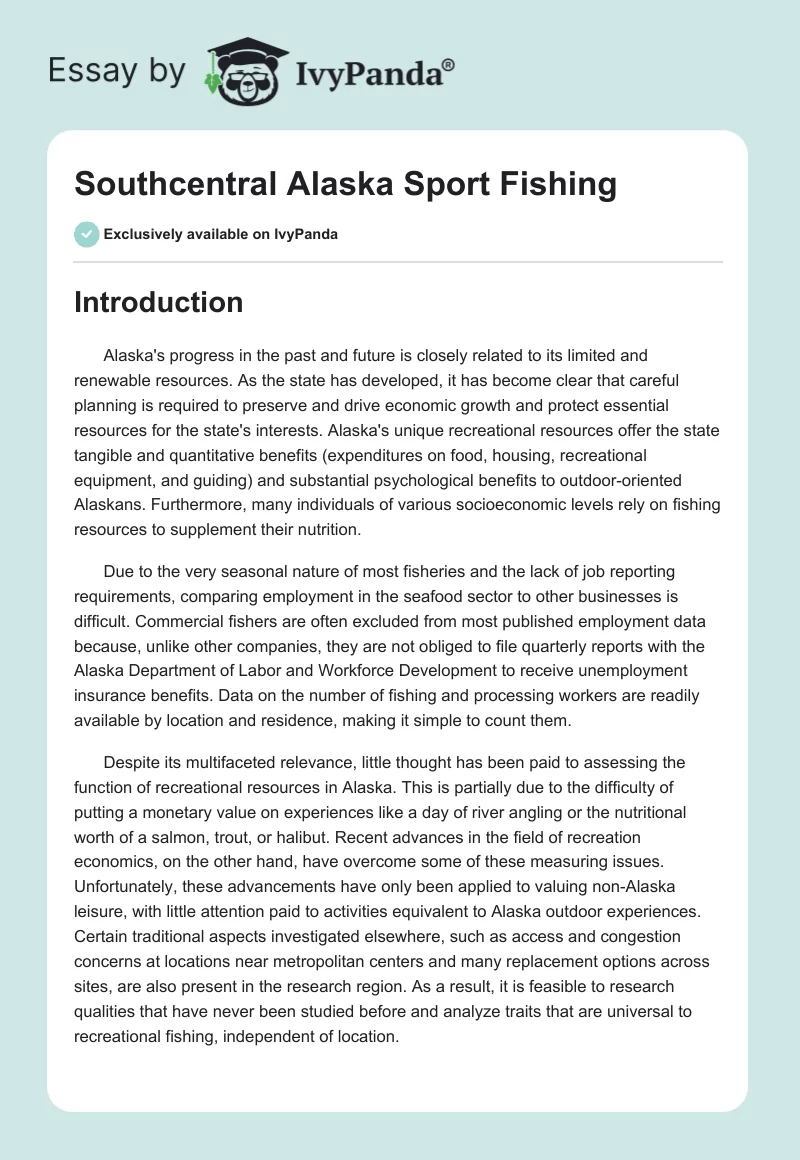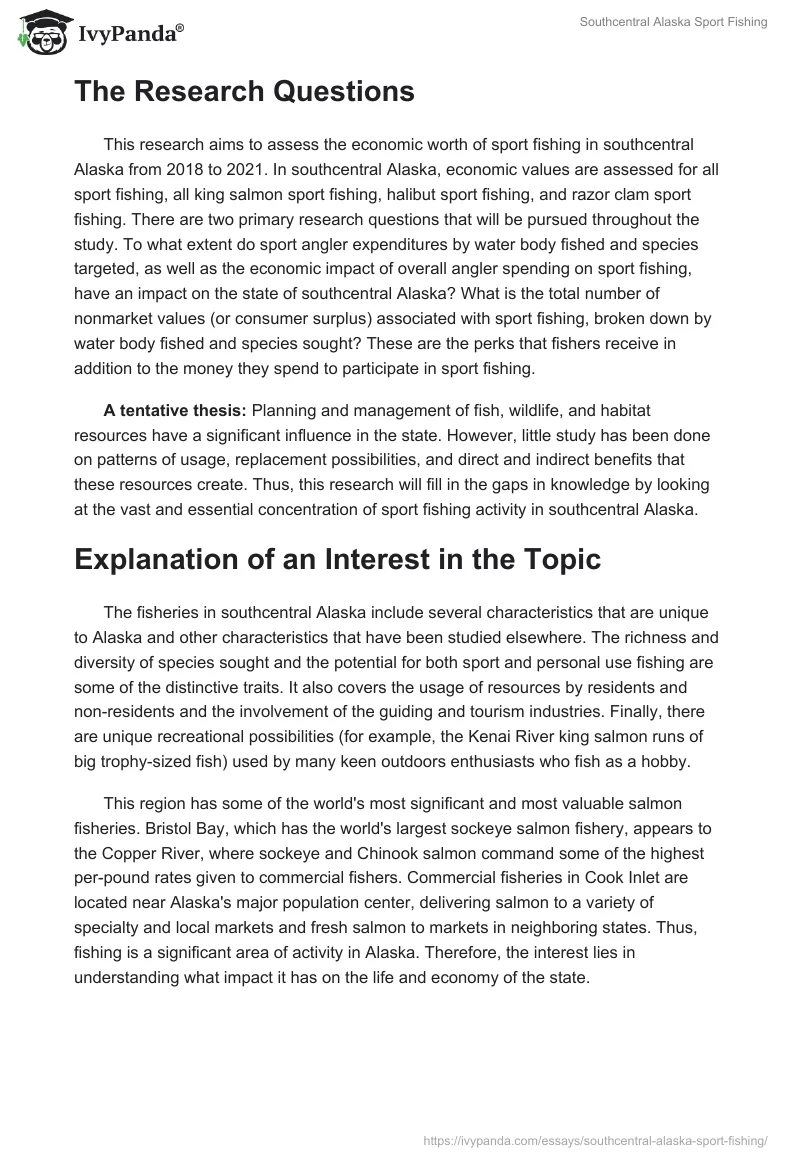Introduction
Alaska’s progress in the past and future is closely related to its limited and renewable resources. As the state has developed, it has become clear that careful planning is required to preserve and drive economic growth and protect essential resources for the state’s interests. Alaska’s unique recreational resources offer the state tangible and quantitative benefits (expenditures on food, housing, recreational equipment, and guiding) and substantial psychological benefits to outdoor-oriented Alaskans. Furthermore, many individuals of various socioeconomic levels rely on fishing resources to supplement their nutrition.
Due to the very seasonal nature of most fisheries and the lack of job reporting requirements, comparing employment in the seafood sector to other businesses is difficult. Commercial fishers are often excluded from most published employment data because, unlike other companies, they are not obliged to file quarterly reports with the Alaska Department of Labor and Workforce Development to receive unemployment insurance benefits. Data on the number of fishing and processing workers are readily available by location and residence, making it simple to count them.
Despite its multifaceted relevance, little thought has been paid to assessing the function of recreational resources in Alaska. This is partially due to the difficulty of putting a monetary value on experiences like a day of river angling or the nutritional worth of a salmon, trout, or halibut. Recent advances in the field of recreation economics, on the other hand, have overcome some of these measuring issues. Unfortunately, these advancements have only been applied to valuing non-Alaska leisure, with little attention paid to activities equivalent to Alaska outdoor experiences. Certain traditional aspects investigated elsewhere, such as access and congestion concerns at locations near metropolitan centers and many replacement options across sites, are also present in the research region. As a result, it is feasible to research qualities that have never been studied before and analyze traits that are universal to recreational fishing, independent of location.
The Research Questions
This research aims to assess the economic worth of sport fishing in southcentral Alaska from 2018 to 2021. In southcentral Alaska, economic values are assessed for all sport fishing, all king salmon sport fishing, halibut sport fishing, and razor clam sport fishing. There are two primary research questions that will be pursued throughout the study. To what extent do sport angler expenditures by water body fished and species targeted, as well as the economic impact of overall angler spending on sport fishing, have an impact on the state of southcentral Alaska? What is the total number of nonmarket values (or consumer surplus) associated with sport fishing, broken down by water body fished and species sought? These are the perks that fishers receive in addition to the money they spend to participate in sport fishing.
A tentative thesis: Planning and management of fish, wildlife, and habitat resources have a significant influence in the state. However, little study has been done on patterns of usage, replacement possibilities, and direct and indirect benefits that these resources create. Thus, this research will fill in the gaps in knowledge by looking at the vast and essential concentration of sport fishing activity in southcentral Alaska.
Explanation of an Interest in the Topic
The fisheries in southcentral Alaska include several characteristics that are unique to Alaska and other characteristics that have been studied elsewhere. The richness and diversity of species sought and the potential for both sport and personal use fishing are some of the distinctive traits. It also covers the usage of resources by residents and non-residents and the involvement of the guiding and tourism industries. Finally, there are unique recreational possibilities (for example, the Kenai River king salmon runs of big trophy-sized fish) used by many keen outdoors enthusiasts who fish as a hobby.
This region has some of the world’s most significant and most valuable salmon fisheries. Bristol Bay, which has the world’s largest sockeye salmon fishery, appears to the Copper River, where sockeye and Chinook salmon command some of the highest per-pound rates given to commercial fishers. Commercial fisheries in Cook Inlet are located near Alaska’s major population center, delivering salmon to a variety of specialty and local markets and fresh salmon to markets in neighboring states. Thus, fishing is a significant area of activity in Alaska. Therefore, the interest lies in understanding what impact it has on the life and economy of the state.
Research Methods
Quantitative research methods focus on objective measurements and statistical, mathematical, or numerical analysis of data acquired through polls, questionnaires, and surveys, as well as modifying pre-existing statistical data using computing tools. Quantitative research is concerned with collecting numerical data and generalizing it across groups of individuals or explaining phenomena. The final written report includes the introduction, literature and theory, methodology, results, and comments. Descriptive research is a type of quantitative study that aims to collect measurable data in order to do statistical analysis on a population sample. It is a common market research method for gathering and describing the characteristics of demographic segments.
None of the variables in descriptive research are impacted in any manner. The research is carried out using observational approaches. As a result, the researcher has no control over the variables’ nature or behavior. A descriptive research approach can be applied in various ways and for a variety of purposes. However, it is critical to understand the survey goals and design before beginning any survey. Close-ended questionnaires are used to make specific inferences about the responses. This might be because of determining the respondents’ patterns, characteristics, and habits. It might also ascertain a respondent’s attitude or viewpoint on the issue.
Researchers frequently utilize descriptive research to determine the research object’s current circumstances and underlying trends. Researchers watch each variable and perform an in-depth study thanks to the non-invasive research approach, quantitative observation, and certain features of qualitative observation. Researchers also use it to confirm any existing disorders that may be widespread in a group. To see whether there are any parallels or differences, the analysis might be done at different times. This also enables the evaluation of any number of variables. Studies on current situations can also be repeated to identify trends for verification.
A Project Schedule
It is worth mentioning that the study will be done in two parts. The first phase will be primarily concerned with data collecting, including survey design, testing, and implementation. To collect the data needed for the economic analysis, intensive surveys of local and non-resident anglers and sport fishing-related companies and guides will be undertaken through the survey. The second phase will focus on data analysis, including processing survey data and secondary data, devising analytical procedures and conducting analyses, and preparing reports.
Works Cited
Baumer, Jay. Area Management Report for the Sport Fisheries of the North Gulf Coast, 2016–2018. Alaska Department of Fish and Game, 2019.
Beaudreau, Anne H., et al. “Harvest Portfolio Diversification and Emergent Conservation Challenges in an Alaskan Recreational Fishery.” Biological Conservation, vol. 222, 2018, pp. 268–77.
Chan, Maggie N., et al. “Evaluating the Recreational Fishery Management Toolbox: Charter Captains’ Perceptions of Harvest Controls, Limited Access, and Quota Leasing in the Guided Halibut Fishing Sector in Alaska.” Marine Policy, vol. 91, 2018, pp. 129–35.
Harris, Bradley. “Ichthyophonus in Sport-Caught Groundfishes From Southcentral Alaska.” Diseases of Aquatic Organisms, vol. 128, no. 2, 2018, pp. 169–73.
Jones, Leslie A., et al. “Watershed‐scale Climate Influences Productivity of Chinook Salmon Populations Across Southcentral Alaska.” Global Change Biology, vol. 26, no. 9, 2020, pp. 4919–36.
Lavoie, Anna, and Amber Himes-Cornell. “Social Networks of Alaska Fishing Communities.” Coastal Management, vol. 47, no. 1, 2019, pp. 1–22.
Lavoie, Anna, et al. “Ground-Truthing Social Vulnerability Indices of Alaska Fishing Communities.” Coastal Management, vol. 46, no. 5, 2018, pp. 359–87.
Lew, Daniel Kevin. Costs, Earnings, and Employment in the Alaska Saltwater Sport Fishing Charter Sector, 2017. Alaska Department of Fish and Game, 2019.
Pickett, Jennifer, and Joeri Hofmans. “Stressors, Coping Mechanisms, and Uplifts of Commercial Fishing in Alaska: A Qualitative Approach to Factors Affecting Human Performance in Extreme Environments.” Journal of Human Performance in Extreme Environments, vol. 15, no. 1, 2019, pp. 1–16.
Szymkowiak, Marysia. “Genderizing Fisheries: Assessing Over Thirty Years of Women’s Participation in Alaska Fisheries.” Marine Policy, vol. 115, 2020, p. 103846.


